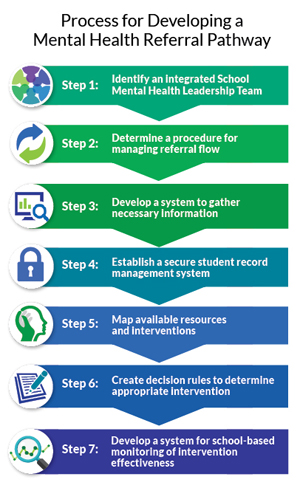The Department of Public Instruction, in coordination with the Wisconsin Safe and Healthy Schools Center, recently released the School Mental Health Referral Pathways Guide to help schools develop a process for identifying and connecting students to necessary mental health supports.
 Mental health referral pathways exist in the context of an equitable, multi-level system of supports, providing a conceptual model for organizing mental health supports in schools. These pathways are important because they:
Mental health referral pathways exist in the context of an equitable, multi-level system of supports, providing a conceptual model for organizing mental health supports in schools. These pathways are important because they:
- Provide the next steps for staff and families after identifying a student in need;
- Coordinate supports within schools and with outside organizations; and
- Improve student outcomes through early identification.
In order to create an effective pathway, schools must consider the specific needs and resources of their school and community. New guidance on the DPI Wisconsin School Mental Health Framework web page outlines the necessary groundwork for building a comprehensive school mental health system.
Liz Krubsack, DPI school mental health consultant, speaks to the importance of publishing a guide like this, “The guide helps how to navigate the continuum of supports to make sure kids are receiving the appropriate level of supports or intervention they have available. The resource mapping process is huge. A lot of times, there is more going on than people realize. Part of the referral pathway is looking at what are the needs and what are the gaps.”
Krubsack also emphasizes that the guide provides specific, actionable information that schools can apply to their system, including templates and examples of ways to set up a mental health pathway, plus a checklist of things to do.
Creating the guide stems from the need to establish local comprehensive school mental health systems. The DPI and the Wisconsin Safe and Healthy Schools Center connected with the field to get input on the guide from schools and districts around the state who were already working on their own referral pathways.
“We hope to see kids getting connected earlier to supports that they need,” Krubsack said. “We’ve seen a lot of schools starting to do this work. The impacts are huge—just being able to coordinate their system so that everyone is on the same page.”
The following resources are available for more information: